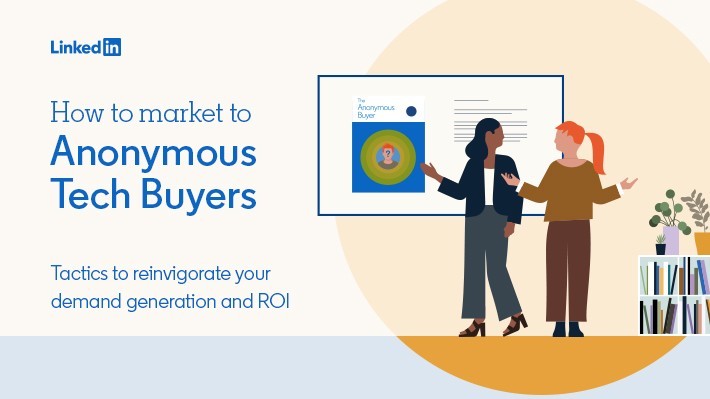Targeting the Anonymous Buyer
The rise of the anonymous buyer has changed the rules of B2B tech marketing by taking sole responsibility for IT buying away from a single, well-defined decision maker – and distributing it across the entire company. Today, four out of every five employees are involved in technology purchases at some stage. The success of your marketing strategy will depend on your ability to target the anonymous buyers driving decisions about your category.
This is a challenge, because anonymous buyers aren’t easily defined by a job title, a role or even a particular level of seniority. They include the heads of different departments advocating for better solutions for their teams, and the developers that a business depends on to update its software and design its customer experiences. However, they also include tech-savvy super users from across a range of different functions, who’ve heard of better ways to run webinars, edit videos or share files. Many anonymous buyers are simply end-users who want things to work better and have the energy and motivation to do something about it. There’s no magical segment or persona that will capture them all – and you can’t rely on them to confess to being anonymous buyers either. LinkedIn research shows that only 25% of today’s B2B buyers are likely to fill in a lead generation form.
So how can you target anonymous buyers effectively? Our new playbook deep dives into all our tactics in detail for prospecting the Anonymous Tech Buyers.
Below are six tactics for reaching the right buyers, at the right moments, whoever they are:
Stick to broader targeting facets rather than specific ones
In the age of the anonymous buyer, trying to reach the right person through a specific set of job titles is like trying to pin a tail on the proverbial donkey. You simply don’t have the granular information about who could be driving a purchase to hyper-target around an exact role. As a general rule, aim to substitute broader targeting criteria for overly specific ones. If you’re tailoring messages to different departments, target by function rather than job title – and be cautious about adding in extra targeting facets like seniority. Can you be certain that only people in senior positions are weighing in on a purchase decision? Where modern IT buying is concerned, you often can’t.
Go big within target accounts
With LinkedIn account targeting, you can specify a list of up to 300,000 specific businesses to target on LinkedIn. If you’ve worked with sales on developing an Account-Based Marketing (ABM) strategy and have a list of priority accounts that you’ve identified as key opportunities, then this provides a great basis for targeting all of the potential anonymous buyers within those accounts – which usually means every employee. By being specific about relevant companies, you can give yourself the freedom to be broad in targeting everyone working there. If you can get everyone at a business talking about your solution, or at least being familiar with it when colleagues mention it to them, you give yourself a big advantage in today’s era of distributed tech decision-making. You can build out your relevant audience of anonymous buyers further still by using the Lookalike Audience feature within LinkedIn’s Campaign Manager to reach people at similar companies.
Use relevant skills to reach anonymous buyers across industry sectors
Through Skills targeting, you can reach across companies, industries and different roles, in order to put your marketing in front of everyone qualified to act as a buyer for your solutions. If you’re marketing a file transfer solution, for example, your relevant anonymous buying audience could be everyone who works with the kind of software packages that produce large files. If you’re promoting headsets, then anyone who handles or makes calls could be relevant to you. Set up a campaign targeting these skills and you’ve built yourself a bespoke anonymous buying segment.
One of the great things about using Skills in targeting is that LinkedIn members are inclusive when they list them – they’re motivated to signal every type of expertise that they have. This means that they opt themselves into your campaign targeting, rather than opting out of it.
At LinkedIn, one of our favourite targeting hacks is to take the keywords from our search marketing campaigns, and type them into the Skills targeting box in LinkedIn Campaign Manager. This quickly generates a list of relevant skills for a campaign to target. Try using it to give yourself a foundation for targeting anonymous buyers through Skills.
Use Interest Targeting to reach all those occupying a buying mindset
Interest Targeting on LinkedIn enables you to reach an audience who are showing relevant, current interest in your category. It does this by triangulating different signals, such as the content that people click on, like and share on LinkedIn, the groups they’re a part of, the Pages they follow, and the terms they search on using Bing. Like targeting using Skills, Interest Targeting enables you to reach beyond specific job titles or functions and target all anonymous buyers who might be relevant to you. And because Interest Targeting picks up on signals of current intent, it gives you an opportunity to tailor content to the later stages of the consideration journey. If you want to share more detailed demand generation content that goes into the specifics and unique selling points of your solution, then Interest Targeting is a great vehicle for putting it in front of people who’ll be ready to engage with that level of detail.
Retarget by function with relevant solutions
Retargeting is another important tactic for starting to move your anonymous buyer messaging down the funnel. By adding the LinkedIn Insight Tag to the global footer of your website, you can build a bespoke audience of potential anonymous buyers who are showing an interest in your business and proposition. These people aren’t necessarily putting their hands up as leads – but they are putting their hands up as being interested in hearing more. This is your signal to target them with more detailed demand generation content, proactively giving them the useful information they’re likely to be searching for. If you offer free trials or live demos of your solution, then this is a great audience to put them in front of. Similarly, if you’ve created an unboxing video or how-to demonstration then these are the people most likely to watch it – and respond.
Ready to learn more? Our new playbook deep dives into all our tactics in detail for prospecting the Anonymous Tech Buyers. Click here to read on.
Topics: Tech marketing Trends, tips, and best practices LinkedIn Ads
Related articles



